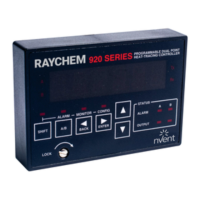14 / 82
EN- Raychem920series-IM-H5687405/15
INDUSTRIAL HEAT TRACING SOLUTIONS
Temperature Sensors Terminal No.
Point A – Shield 25
Point A TS 1 Source (WHT) 26
Point A TS 1 Sense (WHT) 27
Point A TS 1 Common (RED) 28
Point A – Shield 9
Point A TS 2 Source (WHT) 10
Point A TS 2 Sense (WHT) 11
Point A TS 2 Common (RED) 12
Point B – Shield 29
Point B TS 1 Source (WHT) 30
Point B TS 1 Sense (WHT) 31
Point B TS 1 Common (RED) 32
Point B – Shield 13
Point B TS 2 Source (WHT) 14
Point B TS 2 Sense (WHT) 15
Point B TS 2 Common (RED) 16
IMPORTANT: Some RTDs may be constructed with the Sense wire color-coded as Black.
2.7.2 ALARM RELAY CONNECTIONS
The alarm output relay is a programmable dry contact output. It may be programmed for N.O.,
N.C., steady or flashing operation, and is typically used to annunciate an alarm to an external
device such as a DCS, PLC, etc.
IMPORTANT: The alarm relay is intended to be used for switching low-voltage, low-current
signals.
Do not use this relay to directly switch line voltages.
Ensure that your application stays
within the ratings of the relay contacts as defined in Appendix A on page 61.
The alarm relay may also be used in conjunction with the +9 Vdc source to switch an external,
line-voltage relay to drive a local pilot light, etc. Refer to the wiring diagrams in Appendix C on
page 68 for example connection details.
Alarm and Control Signals Terminal No.
Alarm relay dry contact output 17
Alarm relay dry contact output 18
Ground 19
+9 Vdc nominal Out (100 mAmps maximum) 1
Common 2
Common 3
2.7.3 EXTERNAL INPUT/OUTPUT
These input and output terminals are used to implement the Override and Ambient Temperature
Control Mode features. Refer to Section 3 on page 18 for programming details, and Appendix C on
page 68 for example wiring diagrams.
Miscellaneous Signals Terminal No.
External input (+) 20
External input (-) 21
External output (+) 4
External output(-) 5
2.7.4 COMMUNICATION SIGNAL CONNECTIONS
The communications terminal assignments change based on the type of option installed. If present
in a control module, the type of communications interface will be identified by a label located next
to the module’s rating label.

